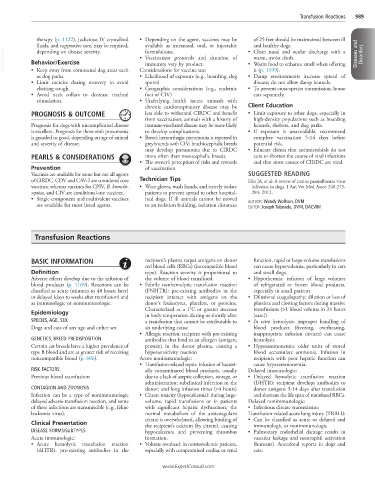Page 1977 - Cote clinical veterinary advisor dogs and cats 4th
P. 1977
Transfusion Reactions 989
therapy (p. 1122), judicious IV crystalloid • Depending on the agent, vaccines may be of 25 feet should be maintained between ill
fluids, and supportive care, may be required, available as intranasal, oral, or injectable • Clean nasal and ocular discharge with a
and healthy dogs.
VetBooks.ir Behavior/Exercise • Vaccination protocols and duration of • Warm food to enhance smell when offering Diseases and Disorders
depending on disease severity.
formulations.
warm, moist cloth.
immunity vary by product.
• Keep away from communal dog areas such
it (p. 1199).
as dog parks. Considerations for vaccine use: • Damp environments increase spread of
• Likelihood of exposure (e.g., boarding, dog
• Limit exercise during recovery to avoid sports) disease; do not allow damp kennels.
eliciting cough. • Geographic considerations (e.g., endemic • To prevent cross-species transmission, house
• Avoid neck collars to decrease tracheal foci of CIV) cats separately.
stimulation. • Underlying health issues: animals with
chronic cardiorespiratory disease may be Client Education
PROGNOSIS & OUTCOME less able to withstand CIRDC and benefit • Limit exposure to other dogs, especially in
from vaccination; animals with a history of high-density populations such as boarding
Prognosis for dogs with uncomplicated disease immune-mediated disease may be more likely kennels, shelters, and dog parks.
is excellent. Prognosis for those with pneumonia to develop complications. • If exposure is unavoidable, recommend
is guarded to good, depending on age of animal • Breed: hemorrhagic pneumonia is reported in complete vaccination 5-14 days before
and severity of disease. greyhounds with CIV; brachiocephalic breeds potential risk.
may develop pneumonia due to CIRDC • Educate clients that antimicrobials do not
PEARLS & CONSIDERATIONS more often than mesocephalic breeds. cure or shorten the course of viral infections
• The owner’s perception of risks and rewards and that most causes of CIRDC are viral.
Prevention of vaccination
Vaccines are available for some but not all agents SUGGESTED READING
of CIRDC. CDV and CAV-2 are considered core Technician Tips Ellis JA, et al: A review of canine parainfluenza virus
vaccines, whereas vaccines for CPIV, B. bronchi- • Wear gloves, wash hands, and strictly isolate infection in dogs. J Am Vet Med Assoc 240:273-
septica, and CIV are conditional-use vaccines. patients to prevent spread to other hospital- 284, 2012.
• Single-component and multivalent vaccines ized dogs. If ill animals cannot be moved AUTHOR: Wendy Wolfson, DVM
are available for most listed agents. to an isolation building, isolation distances EDITOR: Joseph Taboada, DVM, DACVIM
Transfusion Reactions
BASIC INFORMATION recipient’s plasma target antigens on donor function, rapid or large-volume transfusions
red blood cells (RBCs) (incompatible blood can cause hypervolemia, particularly in cats
Definition type). Reaction severity is proportional to and small dogs.
Adverse effects develop due to the infusion of the volume of blood transfused. • Hypothermia: infusion of large volumes
blood products (p. 1169). Reactions can be • Febrile nonhemolytic transfusion reaction of refrigerated or frozen blood products,
classified as acute (minutes to 48 hours later) (FNHTR): pre-existing antibodies in the especially in small patients
or delayed (days to weeks after transfusion) and recipient interact with antigens on the • Dilutional coagulopathy: dilution or loss of
as immunologic or nonimmunologic. donor’s leukocytes, platelets, or proteins. platelets and clotting factors during massive
Characterized as a 1°C or greater increase transfusions (>1 blood volume in 24 hours
Epidemiology in body temperature during or shortly after [rare])
SPECIES, AGE, SEX a transfusion that cannot be attributable to • In vitro hemolysis: improper handling of
Dogs and cats of any age and either sex an underlying cause blood products (freezing, overheating,
• Allergic reaction: recipient with pre-existing inappropriate infusion devices) can cause
GENETICS, BREED PREDISPOSITION antibodies that bind to an allergen (antigen, hemolysis.
Certain cat breeds have a higher prevalence of protein) in the donor plasma, causing a • Hyperammonemia: older units of stored
type B blood and are at greater risk of receiving hypersensitivity reaction blood accumulate ammonia. Infusion in
noncompatible blood (p. 686). Acute nonimmunologic: recipients with poor hepatic function can
• Transfusion-related sepsis: infusion of bacteri- cause hyperammonemia.
RISK FACTORS ally contaminated blood products, usually Delayed immunologic:
Previous blood transfusions due to a lack of aseptic collection, storage, or • Delayed hemolytic transfusion reaction
administration; subclinical infection in the (DHTR): recipient develops antibodies to
CONTAGION AND ZOONOSIS donor; and long infusion times (>4 hours) donor antigens 3-14 days after transfusion
Infection can be a type of nonimmunologic • Citrate toxicity (hypocalcemia): during large- and shortens the life span of transfused RBCs.
delayed adverse transfusion reaction, and some volume, rapid transfusions or in patients Delayed nonimmunologic:
of these infections are transmissible (e.g., feline with significant hepatic dysfunction, the • Infectious disease transmission
leukemia virus). normal metabolism of the anticoagulant Transfusion-related acute lung injury (TRALI):
citrate is overwhelmed, allowing binding of • Can be classified as acute or delayed and
Clinical Presentation the recipient’s calcium (by citrate), causing immunologic or nonimmunologic
DISEASE FORMS/SUBTYPES hypocalcemia and preventing thrombus • Pulmonary endothelial damage results in
Acute immunologic: formation. vascular leakage and neutrophil activation
• Acute hemolytic transfusion reaction • Volume overload: in normovolemic patients, (humans). Anecdotal reports in dogs and
(AHTR): pre-existing antibodies in the especially with compromised cardiac or renal cats.
www.ExpertConsult.com

